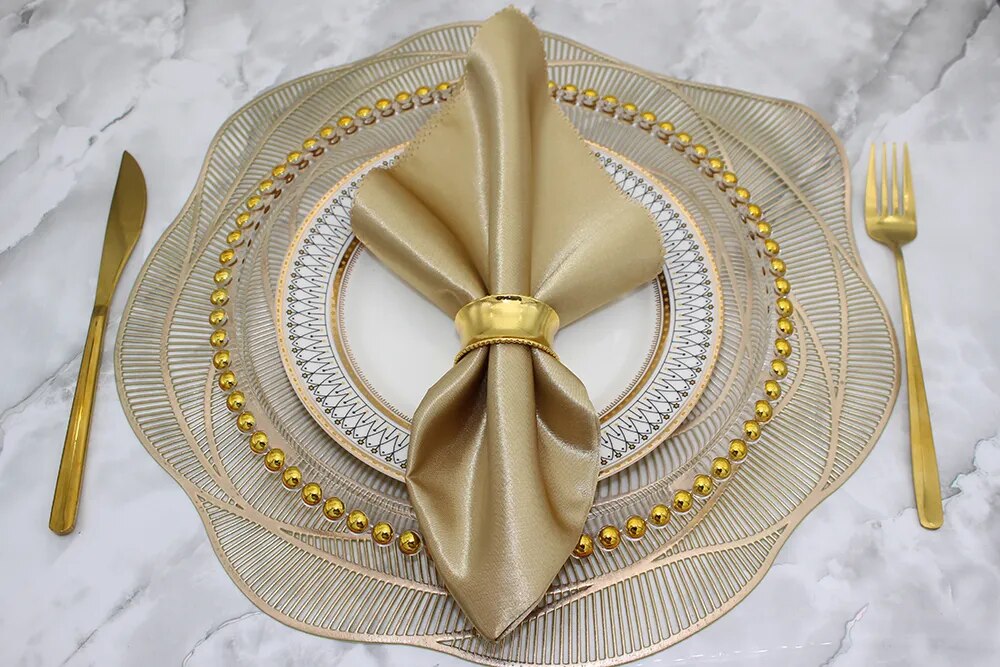
Introduction: Elevating Table Décor with Napkin Holders
These are a small yet significant detail that can elevate the aesthetic of any dining table. These functional accessories serve not only to keep napkins neatly organized but also to enhance the overall ambiance of a meal, whether it’s a casual family dinner or a formal gathering. With designs ranging from classic to contemporary, these can be a stylish addition to your table setting, reflecting your personal taste and the theme of your dining experience.
As the shopping season for home décor and dining accessories approaches, now is the perfect time to explore the world of napkin holders. This comprehensive guide will delve into the history, styles, and materials of it, as well as offer tips on selecting the perfect holder for your needs.
The History of Napkin Holders
These have evolved over the centuries, reflecting changes in dining customs and decorative trends:
- Early Origins: Napkins themselves date back to ancient times, with the Romans and Greeks using pieces of cloth during meals. However, the concept of it did not emerge until later, when dining became more formalized.
- 18th and 19th Centuries: During the 18th and 19th centuries, as dining became an elaborate ritual, napkin holders started to gain popularity. These were often crafted from silver or other precious metals and were used in aristocratic households to showcase wealth and refinement.
- Victorian Era: The Victorian era saw a surge in the use of napkin rings, which were a precursor to the modern holder. These rings were often personalized with engravings and were considered a symbol of social status.
- 20th Century: The 20th century brought about a variety of napkin holder designs, with a focus on both functionality and aesthetics. The development of new materials such as plastic and stainless steel made more accessible to the general public.
- Contemporary Trends: Today, these are available in a wide range of styles, from minimalist to ornate, and are used in both casual and formal settings. The rise of DIY and handmade items has also led to a resurgence in personalized and artisanal napkin holders.
Benefits of Using a Napkin Holder
These offer several benefits that make them a practical and decorative addition to any table setting:
- Organization: Napkin holders keep napkins neatly organized and within easy reach, helping to maintain a tidy table and reduce clutter.
- Aesthetic Appeal: A well-chosen can enhance the visual appeal of your table setting, complementing your dinnerware and other décor elements.
- Convenience: Napkin holders make it easy for guests to access napkins during a meal, adding a touch of hospitality to your dining experience.
- Versatility: These are versatile accessories that can be used for various occasions, from everyday meals to special events. They can also be easily switched out to match different themes or seasons.
- Personalization: Many napkin holders can be personalized with initials, names, or special designs, making them a thoughtful gift or a unique addition to your home.
When Is Napkin Holder Shopping Season?
The shopping season often coincides with times when people are focused on home décor and entertaining. Here are some key periods to consider:
- Holiday Season (November to December): The holiday season is a prime time for purchasing napkin holders, as many people are preparing for festive gatherings and looking to enhance their table settings. Many retailers offer seasonal designs and holiday-themed collections during this period.
- Wedding and Event Season (April to September): As wedding and event season approaches, many couples and event planners seek out elegant and personalized napkin holders to complement their décor. This is an excellent time to find special occasion designs.
- Spring Cleaning and Home Refresh (March to May): The arrival of spring often prompts people to refresh their homes, including their dining areas. This is a good time to shop for new holders that reflect the season’s lighter, brighter aesthetic.
- Back-to-School Season (August to September): During the back-to-school season, many families are focused on organizing their homes and preparing for busy schedules. Simple, functional napkin holders can be a practical addition to the kitchen or dining room.
Styles and Materials: Choosing the Right Napkin Holder
These come in a variety of styles and materials, each offering a different look and feel:
- Styles:
- Classic : Classic napkin holders feature timeless designs that work well with traditional table settings. They often have a simple, elegant shape, such as a rectangular or square form, and may be adorned with subtle details like engravings or monograms.
- Modern : Modern have a sleek, minimalist design that complements contemporary dining spaces. These holders often feature clean lines, geometric shapes, and a focus on functionality.
- Rustic : Rustic napkin holders are ideal for farmhouse or country-style décor. They are often made from natural materials like wood or metal and may feature distressed finishes or handcrafted details.
- Decorative : Decorative are designed to be eye-catching and can serve as a focal point on your table. These holders may incorporate intricate patterns, artistic motifs, or seasonal themes.
- Themed : Themed napkin holders are perfect for special occasions or holidays. These holders are often shaped like objects or characters related to a specific theme, such as Christmas trees, pumpkins, or animals.
- Personalized : Personalized allow you to add a unique touch to your table setting. These holders can be engraved with names, initials, or special messages, making them a meaningful gift or keepsake.
- Materials:
- Metal: Metal napkin holders are durable and versatile, available in a variety of finishes such as stainless steel, brass, copper, and silver. They can range from sleek and modern to ornate and traditional.
- Wood: Wood offer a warm, natural look that complements rustic or farmhouse-style décor. They can be crafted from different types of wood, such as oak, pine, or walnut, and may feature carvings or painted designs.
- Ceramic: Ceramic napkin holders are often hand-painted and come in a variety of colors and patterns. They add a charming, artistic touch to your table and are available in both traditional and contemporary styles.
- Glass: Glass are elegant and timeless, often featuring clear or colored glass with intricate designs or etchings. They are ideal for formal dining settings or special occasions.
- Plastic: Plastic napkin holders are lightweight, affordable, and available in a wide range of colors and styles. They are a practical choice for everyday use, especially in households with children.
- Resin: Resin are durable and can be molded into various shapes and designs. They are often used for themed or decorative holders, offering a high level of detail and creativity.
- Features:
- Weighted Base: A weighted base helps keep the napkin holder stable, preventing it from tipping over, especially when holding a large number of napkins.
- Vertical vs. Horizontal: These can be designed to hold napkins vertically or horizontally. Vertical holders are often more compact, while horizontal holders can display napkins more prominently.
- Single Slot vs. Multiple Slots: Some napkin holders have a single slot for napkins, while others feature multiple slots or compartments, allowing for the organization of different types of napkins or additional items like utensils.
- Decorative Elements: Many feature decorative elements such as engravings, inlays, or embellishments that add visual interest and complement your table décor.
- Customization Options: Personalized napkin holders can be customized with names, initials, or designs, making them a unique addition to your table or a thoughtful gift.
Tips for Shopping During Napkin Holder Season
When shopping for it, consider the following tips to make the best choice:
- Match Your Décor: Choose a napkin holder that complements your existing tableware and décor. Consider the colors, materials, and overall style of your dining space to ensure a cohesive look.
- Consider Functionality: Think about how you will use it. If you host large gatherings, a holder with a large capacity or multiple slots may be more practical. For everyday use, a simple, easy-to-clean design may be ideal.
- Check the Size: Ensure that the napkin holder is the right size for the napkins you use. Some holders are designed for standard-size napkins, while others may be larger or smaller.
- Look for Durability: Invest in a high-quality made from durable materials. A well-made holder will last longer and continue to look good over time.
- Explore Seasonal Options: During the holiday season, many retailers offer special collections of napkin holders with festive designs. Consider purchasing a seasonal holder to add a touch of holiday spirit to your table.
Care and Maintenance of Napkin Holders
To keep your napkin holder in good condition, follow these care and maintenance tips:
- Regular Cleaning: Wipe down regularly to remove dust and debris. For metal or glass holders, use a soft cloth and a mild cleaner. Wooden holders may require occasional polishing to maintain their finish.
- Avoid Moisture: Keep your napkin holder dry to prevent rust, tarnish, or warping. If your holder is made from metal or wood, avoid placing it in damp areas or exposing it to excessive moisture.
- Handle with Care: Be gentle when handling delicate materials like glass or ceramic to avoid chips or cracks. Store these holders in a safe place when not in use to prevent damage.
- Check for Wear: Periodically inspect your napkin holder for signs of wear, such as loose parts, scratches, or fading. Address any issues promptly to prolong the life of the holder.
- Store Seasonally: If you have seasonal or themed holders, store them properly when not in use. Keep them in a cool, dry place and wrap them in protective material to prevent damage.
Conclusion: Enhancing Your Dining Experience with the Perfect Napkin Holder
A napkin holder may seem like a small detail, but it can have a big impact on the overall look and feel of your table setting. Whether you’re preparing for a special occasion or simply want to add a touch of elegance to your everyday meals, the right one can make all the difference. As the shopping season for home décor approaches, take the time to explore the various styles, materials, and features available in holders. With the guidance provided in this comprehensive guide, you’ll be well-equipped to find the perfect one to suit your style and enhance your dining experience.


